George Vincent (painter)
George Vincent (27 June 1796 – c. 1832) was an English landscape artist. He is considered to be one of the most talented of the Norwich School of painters, a group of artists who all worked or lived in Norwich during all or part of their working lives from around 1800 to 1880. His work was founded on the style of John Crome, also of the Norwich School, and the Dutch School of landscape painting.
George Vincent | |
|---|---|
 John Jackson's portrait of Vincent (National Portrait Gallery, London) | |
| Born | June 27, 1796 |
| Died | c. 1832 possibly Bath, Somerset |
| Nationality | English |
| Education | Norwich School; trained by John Crome (1768–1821) |
| Known for | landscape painting |
Notable work | View of Greenwich Hospital from the River (1827) |
| Movement | Norwich School of painters |
| Spouse(s) | Mary Cugnoni |
| Elected | member of the Norwich Society of Artists (1815–31) |
The son of a weaver, Vincent was educated at Norwich Grammar School and afterwards apprenticed to Crome. From 1811 until 1831 he exhibited annually at the Norwich Society of Artists, showing more than one hundred pictures in all, mostly of Norfolk landscapes and marine works. He also exhibited at the Royal Academy, the British Institution, and elsewhere. By 1818 he had relocated to London, marrying the supposedly wealthy daughter of a surgeon in 1821. He was successful in obtaining the patronage of wealthy clients, but then began to struggle financially. The purchase of a grand house in London, combined with a tendency to drink, exacerbated his financial problems, and in 1824 he was incarcerated in the Fleet Prison for debt. Before his release in 1827 he had resumed his connection with the Norwich Society of Artists, albeit with a much declined output of work.
After 1831, when he is known to have contributed to an art exhibition in Norwich, Vincent disappeared. He was never found, despite attempts by his family to locate him, and his whereabouts after this date remain uncertain. There is some evidence that he died before April 1832, perhaps in Bath. He was largely forgotten, until his picture Greenwich Hospital from the River (painted in 1827, also called Greenwich Hospital), shown in an exhibition in London thirty years after his death, caused renewed interest in his paintings. The event helped to establish his reputation as a leading member of the Norwich School, along with the realisation that had George Vincent lived, he could have been one of Britain's great landscape painters.
Background
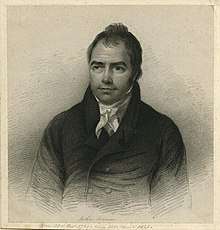
The Norwich School of painters, which included Vincent, was a group connected by geographical location, the depiction of Norwich and rural Norfolk, and by close personal and professional relationships. The school's most important artists were John Crome, Joseph Stannard, George Vincent, Robert Ladbrooke, James Stark, John Thirtle and John Sell Cotman, along with Cotman's sons Miles Edmund and John Joseph Cotman. The Norwich School was a unique phenomenon in the history of 19th-century British art.[1] Norwich was the first English city outside London where a school of artists arose,[2] and had more local-born artists than any subsequently-formed school elsewhere.[3] Norwich's theatrical, artistic, philosophical and musical cultures were cross-fertilised in a way that was unique outside London.[2][4]
Within the Norwich School was the Norwich Society of Artists, which arose from the need for a group of Norwich artists to teach each other and their pupils. Though not all of the members of the Norwich School were also members of the Norwich Society, the latter was key in establishing the artists' associations with each other.[5] The Society, in which Vincent would become a member, was founded in 1803.[6] Its stated aims were "to conduct an Enquiry into the Rise, Progress and Present State of Painting, Archaeology and Sculpture with a view to point out the Best Methods of Study to attain to Greater Perfection in these Arts".[7] It held regular exhibitions and had an organised structure, showing works annually until 1825 and again from 1828 until it was dissolved in 1833.[8] The leading spirits and finest artists of the movement were Crome and Cotman.[9][1][note 1]
The impact of the Norwich School outside East Anglia was based largely upon the works of Vincent and Stark, who were seen as important members of the second generation of the school, and whose exhibited paintings in the capital attracted much praise in the London press. Their connection with their home city was only occasionally noted, as the Norwich School was regarded at the time as being a provincial teaching centre.[11] Interest in paintings by the Norwich School declined during the 1830s, but the school's reputation rose after the Royal Academy's 1878 Winter Exhibition.[12] By the end of the century, however, its paintings, which had once been regarded as modern and progressive, were seen as belonging to a bygone age. This has been attributed by the Professor Andrew Hemingway to the "mythology of rural Englishness" that prevailed at the start of the 20th century.[13] He has commented on a lack of analysis of the Norwich School, such as connections between the Norwich School painters and other artists and developments in landscape painting during the 19th century.[14]
Life
Boyhood
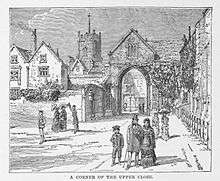
Little is known of George Vincent's early childhood. He was born at Norwich in Norfolk, the son of James Vincent and Mary Freeman, and was baptised by his parents on 27 June 1796, at St John the Baptist's Church, Timberhill, Norwich.[15] Two years earlier another son named George had died in infancy.[16] James Vincent was a weaver who manufactured shawls.[17] His first wife Mary died in 1800.[18] On his mother's side George was a cousin of Sir William Jackson Hooker, a renowned botanical illustrator who in 1841 became the Director of the Royal Botanic Gardens, Kew.[19] James Vincent lived at one time in St. Clement's Church Alley, close to the River Wensum in the centre of the city.[18]
According to an 1885 article from the Eastern Daily Press, the young Vincent enjoyed drawing with charcoal.[20] He was educated at Norwich Grammar School, where he became good friends with John Berney Crome and his brother Frederick, the young sons of the artist John Crome,[21] along with James Stark, whose father was a dyer and who would have known George Vincent's father through his business connections.[22]
Early adulthood (1812–21)
On leaving school, Vincent was apprenticed to Crome, perhaps as early as 1812,[23] along with fellow pupils John Berney Crome and James Stark. The three friends, of whom Vincent was the most talented,[18] travelled together on sketching and painting trips, influencing each other's artistic styles in the process.[24] In January 1816 Vincent travelled to France and Holland along with John Berney Crome and a surgeon named Benjamin Steel, who was to marry John Berney's sister Hannah six years later.[25][note 2] In a letter written by John Crome, Vincent was reported to be seasick during the crossing to France.[27] According to the art historian Andrew Moore, his painting Rouen, now held in the Norfolk Museums Collections,[20][28] was presumably painted as a result of the journey to Paris and is the only painting that he produced from this visit.[29] After returning from the continent he toured Essex, during which time he painted works depicting the villages of Ingatestone and Little Baddow.[22] In around 1818 he left Norwich and moved to London, living first at 7 Wells Street,[23] and then at 86 Newman Street, where he lived until 1821.[30][note 3]
In 1817, together with James Stark, he enrolled as a student at the British Institute's school, but after two years Stark was forced to return home to Norwich due to ill health.[22] In 1821 George Vincent was present with James Stark at John Crome's funeral, having travelled from London to Norwich. At this time Vincent was himself ill, although the reason for his poor health is not given by any sources or mentioned in his published letters.[note 4] The art historian Josephine Walpole considers Vincent's old teacher to have acted as a steadying influence, without which, his misfortunes began.[32][33]
Marriage and subsequent decline
.jpg)
On 3 November 1821 Vincent married nineteen-year-old Mary Elizabeth Cugnoni, the only daughter of the physician James Cugnoni, who was, according to James Stark, extremely wealthy.[23][34] The event was recorded in the Norfolk Chronicle a week later.[35] No children are known to have been produced from the marriage. Vincent bought what the art historians Richard and Samuel Redgrave considered a "good house" in Camden Town,[36][note 5] which was subsequently sold when his wife's money failed to materialise, for reasons that have never been explained,[32] and he was unable to generate enough income from his paintings. By the summer of 1824 Vincent and his wife had moved and were living at 26 Upper Thornhaugh Street, close to Bedford Square, in a more affordable house closer to the centre of London.[22][note 6]
Vincent's health deteriorated and his debts mounted, in part because of his drinking habits.[18][41] A letter dated 27 July 1824 written by Vincent to his Norwich friend William Davey, who was a neighbour of James Stark in Norwich, referred briefly to an unexplained "past folly". The 'folly' referred to in the letter seems to have been the cause of a permanent rift between Vincent and Stark, as well as with Vincent's father, already troubled by his intemperance. The letter is one of a group he wrote to Davey, which reveal his serious financial problems and the "infamy" which was levelled at him.[42][note 7] No details have emerged about the nature of the "past folly" mentioned in the letter. In another letter written in October that year to Davey, Vincent mentioned, "To me it has been — and likewise to my better half — a great source of pleasure to wander over the scenes of former days", with the implication that he was still happily married at this time.[44]
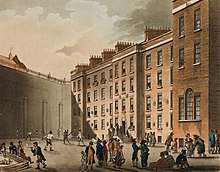
Vincent's increasing alcoholism exacerbated his debt problems.[32] He was committed to London's Fleet Prison in December 1824, where he was forced to remain until his release on 13 February 1827.[18][45] With the help of his father-in-law and his friends he was able to exhibit his paintings, including five that were shown in Norwich (Entrance to Loch Katrine - moonlight; Highlanders Spearing Salmon and four paintings simply entitled Landscape).[46] He was permitted to travel back to Norwich in the company of a prison keeper, most probably so as to raise funds from the sale of his paintings, or to acquire money by some other means. He revealed the embarrassment he felt upon being incarcerated in a debtors' prison in a letter to Davey written in December 1824, requesting, "As it will be necessary to name it to J.S., beg of him not to notice my residence to a soul; and, above all, do not name it to my father, as it would make the poor old man very miserable".[44][note 8]
Disappearance (from 1831)
After 1831, four years after his release from debtors' prison, Vincent disappeared from public view, and was not heard from or seen by his friends again, despite attempts by his family to locate him. Sir Joseph Dalton Hooker, writing in his father's 1902 biography, stated that "George Vincent was well educated and brought up, but lost himself. My father, his cousin, vainly endeavoured to trace his end in London".[19] In the catalogue of his pictures shown by the Society of British Artists in 1832, he was described as "deceased", but uncertainty surrounds both the date and cause of his death. He may have died at some time before 14 April 1832, possibly in a Bath workhouse,[47] as a notice appeared in the Norwich Mercury on that day: "Died lately at Bath, in his 36th year, Mr George Vincent, artist, son of Mr. James Vincent, of this city".[20][17] The writer Ralph Hale Mottram, who described Vincent's appearance from his portraits as that of a boy who was too sensitive to withstand a life of sea travel or heavy drinking, described Vincent's death as "completely mysterious". He suggested that Vincent's wish to avoid creditors was a possible reason for his disappearance.[48]
According to the Morning Advertiser, the belongings of Vincent's London house were sold in January 1833.[49] The 1899 edition of the Dictionary of National Biography claimed that he was last seen by his family when he attended his father's funeral in April 1833, but it is unclear how Campbell Dodgson, who wrote the article, knew this to be true.[18] On 2 May 1833, Mary Vincent married a journalist named Thomas Murphy.[50]
Artistic career
%2C_with_landscape_background_by_himself'.jpg)
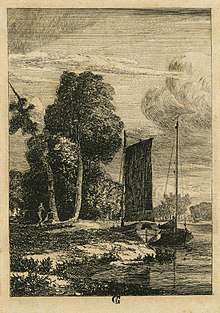
George Vincent, along with John Crome, John Sell Cotman and James Stark, was considered by the art historian Herbert Minton Cundall (1848–1940) to be one of principal artists of the Norwich School. His work was founded on the style of his master, John Crome, and on landscapes of the Dutch Golden Age of paintings.[51]
Vincent's first exhibited works, two of which were described as "after Crome", were shown in Norwich at Sir Benjamin Wrench's Court in 1811 and 1812.[46] From then until 1831 he exhibited there with the Norwich Society of Artists every year, showing a total of 106 pictures, including seventy-five landscapes, six seascapes and sixteen architectural works.[52] In 1818 Vincent was elected as a member of the Norwich Society of Artists; he remained a full-time member until 1831.[53] The Society, which was founded in 1803 and held annual exhibitions in Norwich until 1825, and then from 1827 to 1833, had in its time 79 formal members, including Vincent.[54]
Vincent exhibited a total of nine works at the Royal Academy,[55] forty-one at the British Institution (yearly from 1815 to 1831, except 1816 and 1828),[56] and twelve at Suffolk Street.[22] He also exhibited in Manchester and Glasgow.[20] He was not a regular exhibitor in London until his relocation from Norfolk to the capital. In 1820 he exhibited at the Society of Painters in Oil and Watercolours his London from the Surrey Side of Waterloo Bridge,[note 10] considered by the author and art historian William Frederick Dickes to be an important work. It was purchased by John Leicester, 1st Baron de Tabley and shown to the public in his gallery in London before being relocated to his collection at Tabley House, in Cheshire.[57][20] Vincent's exhibited pictures were mostly views of the Norfolk countryside, but also of Scottish scenes and of boats, and in 1816 he and James Stark both exhibited views of Windsor after touring the area together.[22] In 1819 he embarked on his first tour of Scotland, which resulted in paintings such as View of Edinburgh from Calton Hill and Fishing Boats on the Bank of the Forth — the quality of which, according to the art historian and author Harold Day, gives evidence that he was at the height of his powers during this period.[22]
In 1824 Vincent started to prepare two pictures, of the Battle of the Nile and the Battle of Trafalgar, to compete for a prize offered by the directors of the British Gallery.[18] Although living in London, he still saw himself as a Norfolk man, writing of Nelson, "The Norfolk hero gained those battles, and shall it be said that Norfolk artists would not contend for the prize now offered?"[17] Neither work was completed, because of his imprisonment in the Fleet Prison.[18] In 1825, when he was permitted to travel from prison to visit James Stark at Norwich, he attempted to resume his connection with the Norwich Society. A year after his release in February 1827, he sent six pictures to the Norwich exhibition, and in 1831 he exhibited his last picture there.[18]
Vincent's works were often dated, and signed with his own GV monogram.[20] Of the etchings of his own works made between 1820 and 1827, twelve are now held at the British Museum.[58] Earlier etchings were made before he left Norwich for a career in London.[18]
Influences, reputation and legacy
George Vincent's work was influenced by Crome's paintings, among them A Fishmarket at Boulogne (1820). According to Moore, Vincent approached Crome's naturalism, but was notably inferior with regard to sense of composition.[59] Vincent's work was likewise influenced by the paintings of John Constable, whom he is known to have admired, and by J. M. W. Turner; both lived in London when Vincent was based in the capital.[60] Vincent has also been compared favourably with his contemporary James Stark. According to Cundall, Stark produced paintings that were less atmospheric than those produced by Vincent, who was in his opinion the finer painter;[17] according to the author and collector Derek Clifford, Vincent was also the better watercolourist.[61][62]
Cundall believed that had Vincent "not given way to intemperate habits he would probably have ranked amongst the foremost of British landscape painters".[17] Moore regarded Vincent as one of the most talented British artists of the 1820s, if inconsistent in quality.[23] Campbell Dodgson's biography of George Vincent in the latest version of the Dictionary of National Biography describes him as Crome's most accomplished pupil, whose paintings constitute a remarkable body of work.[20] Walpole, whilst acknowledging Vincent's output as "uneven", has written of him as a man whose death caused the loss of an artist of ambition and tremendous talent, who in his early years bore the hallmark of genius. Among the qualities she singles out are his ability to balance his pictures with unusual skies, his harmonious use of colour, and his way of producing interesting and complex works that were well thought out and constructed. She has praised his Scottish oil paintings in particular, describing them as "absolutely magnificent".[63] The decline in his health and fortunes from the mid 1820s was to Walpole the cause of the general decline in the quality of his output from that time.[64]
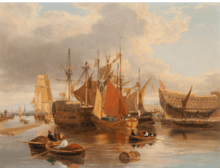
Several of Vincent's paintings have been sold at auction in recent years. Ship Building at Greenwich (1823) (31 x 40 cm), which was sold at Bonhams in 2011, fetched £22,000.[65] St Benet’s Abbey, Norfolk (43 x 60 cm) sold in its original Norwich frame in a 2017 auction for £4,700. His Cattle watering before Windsor Castle realised £1,250 at Christie's in London in 2009, and Shepherds resting on a hillside with a riverside town beyond realised £2,200 there in 2014.[66][67] Prices for his works have also been lower than these, with £720 being fetched in 2015 for Figures in a Wooded Lane with Cottage in Distance, an oil measuring 43 x 22 cm.[68]
Selected paintings
Greenwich Hospital from the River (1827)
George Vincent's talents as a landscape painter went largely unrecognised outside Norwich until 1862, when his 1827 work Greenwich Hospital from the River was shown at the International Exhibition.[18][69][note 11] This large picture helped to secure his reputation as a great landscape painter.[71][72] The Redgraves, writing in 1890 in the Landmarks in Art History series, described Vincent's "noble" and "thoroughly executed" painting as indicative of what he was capable of producing when at the height of his powers.[73] According to William Dickes, Greenwich Hospital from the River was Vincent's masterpiece, comparable with the works of Dutch landscape painters Aelbert Cuyp and Jan van de Cappelle.[70]
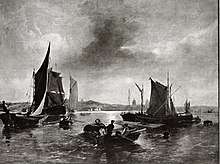
Dickes described Greenwich Hospital from the River in his book on the artists of the Norwich School: "The sun is behind a golden-fringed cloud above the centre of the picture, its light suffusing the sky and powerfully reflected on the river between two groups of ships, where a timber raft is floating. In the front, dark against this light, three sailors in a boat are tying a rope to a buoy. There are other boats moving about, and in the distance between and beyond the timber ships, riverside craft and the towers of Greenwich Hospital". The painting was originally commissioned for a hundred guineas by a Mr Carpenter, as a result of the action of Vincent's friend James Wadmore. Wadmore, who had purchased View on the Wensum from George Vincent in 1819, stipulated that Carpenter should commission the picture in return for some of Wadmore's important manuscripts, required by Carpenter for his own use. The commission would have provided a much-needed source of income for Vincent.[70]
The painting was possibly the one lent by Wadmore to the Society of British Artists and exhibited in 1834.[74] It was exhibited at the 1862 International Exhibition, sold in 1866 (after Wadmore's death) to a Mr Fordham of Stourton Castle, and then passed to William Orme Foster (1814–1899);[70][18] Foster lent it to another exhibition in 1877.[75] A Spectator article of that year described the work as "a fine, vigorous painting, the drawing and grouping of the boats being first-rate, and the sky also exceptionally good".[76]
Vincent painted Greenwich Hospital from the River Thames twice: a second, smaller painting, also known as Greenwich Hospital, was also painted in 1827.[77] Dickes was the author of The Norwich School of Painting, a book that Peter Kennedy-Scott has described as "the Bible of the Norwich School".[78]
Other paintings

Paintings by Vincent are held in museums and galleries around the UK. Middle Mill, Wandsworth is part of the British Government's Art Collection and is on display at the British Embassy in Luxembourg.[79]
The background to Joseph Clover's Portrait of George Vincent (1796-1832), with landscape background by himself was painted by Vincent. The painting was bequeathed to the Norwich Castle Museum in 1899 by J. J. Colman, along with Trowse Meadows, near Norwich. The Eastern Daily Press reported in 1885 that in contrast with the portrait, Vincent's actual face was "disfigured by small-pox, and that he was a very plain man".[20][80]
At least one work by Vincent has been confused with those by Crome's son, John Berney Crome: A View of Yarmouth from Gorleston was once reputed to being by John Berney Crome when it was sold, but it was afterwards found to be by Vincent, when a boat depicted in the picture was shown to have his initials on the side.[81]
The following selection of his works were praised by the press when they were first shown in public, or have been highlighted as noteworthy by art historians of the Norwich School:
- A Distant View of Pevensey Bay, the Landing Place of King William the Conqueror (1824) Norwich Museums Collections [82]
- A Shady country road (undated) Victoria & Albert Museum. The V&A supports an attribution to John Joseph Cotman.[83]
- Entrance to Loch Katrine - moonlight; Highlanders Spearing Salmon, also called Highlanders Spearing Salmon (exhibited 1825) Norfolk Museums Collections [84]
- London from the Surrey Side of Waterloo Bridge (1820) [85]
- Rouen (1816) Norwich Museums Collections [86]
- Driving the Flock, St Mary's, Beverley [87]
- The Dutch Fair at Great Yarmouth, also called Dutch Fair on Yarmouth Beach, (1821) Norwich Museums Collections [88]
- The Needles (1830) Norwich Museums Collections [89]
- Trowse Meadows, near Norwich (1828) Norwich Museums Collections [90]
- View from Sandlings Ferry [91]
Gallery
 Rouen (1816), Norfolk Museums Collections
Rouen (1816), Norfolk Museums Collections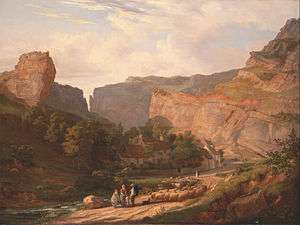 A View of Cheddar Gorge (c. 1820), Yale Center for British Art
A View of Cheddar Gorge (c. 1820), Yale Center for British Art A Harbour Scene in the Isle of Wight, Looking Towards the Needles (1824), Yale Center for British Art
A Harbour Scene in the Isle of Wight, Looking Towards the Needles (1824), Yale Center for British Art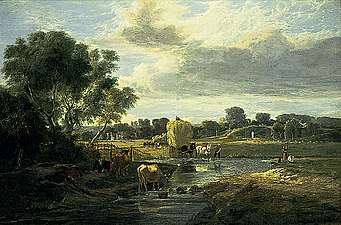 Trowse Meadows, near Norwich (undated), Norfolk Museums Collections.[note 12]
Trowse Meadows, near Norwich (undated), Norfolk Museums Collections.[note 12].jpg) London from the Surrey Side of Waterloo Bridge (1820) (engraved in 1825 by John Young)
London from the Surrey Side of Waterloo Bridge (1820) (engraved in 1825 by John Young) A distant view of Pevensey Bay, the landing place of King William the Conqueror (1820), Norfolk Museums Collections
A distant view of Pevensey Bay, the landing place of King William the Conqueror (1820), Norfolk Museums Collections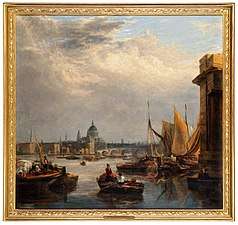 St. Paul's from the Surrey Side of Blackfriars Bridge, figures and sailing barges in the foreground (undated)
St. Paul's from the Surrey Side of Blackfriars Bridge, figures and sailing barges in the foreground (undated)
Notes
- James Reeve, an early authority on the Norwich School, said of John Crome and John Sell Cotman, "Although Crome had not the early advantages in education, etc., that Cotman had, great credit is due to him for the way he educated and improved himself, and in mature life the society in which he moved was in some cases quite equal to that of Cotman. Their feeling for art was altogether different, but they must have had much in common and were good friends".[10]
- Parish records show that Benjamin Steel married John Crome's youngest daughter Hannah on 27 June 1822, at St George's Church, Colegate, Norwich.[26]
- Vincent lived next door to James Stark whilst at Newman Street. According to Ann Cox-Johnson, quoted in the Survey of London: South-East Marylebone: Volumes 51 and 52, it was then a street where nearly every house was occupied by working artists, and “by the time a Newman Street address had become a step on the road to fame, the really famous had moved out”.[31]
- See Dickes, The Norwich School of Painters, pp. 409–505 for transcripts of Vincent's correspondence from London to his friend Davey.
- The house was referred to by some sources as being in Kentish Town.[37]
- Upper Thornaugh Street, parallel to Tottenham Court Road and north of Bedford Square, was renamed Huntley Street in the 1830s. The street appeared on London maps of the period labelled with either name.[38] All the streets where Vincent lived can be found using Christopher Greenwood's[39] and George Cruchley's[40] 1827 maps of London.
- Correspondence from Vincent to his friend William Davey are held in the British Library.[43]
- Part of the letter written from Vincent to his friend in Norwich reads: "I shall experience very great inconvenience from being shut up in this miserable place. I can paint small pictures here but not any of size, but this is not the only evil. Being excluded from the world I shall find it no small difficulty to dispose of my works when painted, and, should I reserve them for the Exhibition, in all probability the money may not be forthcoming until after the close. Having two small pictures finished, intended for the British Gallery, the one 36 x 25, A View in Glen Skerrah, near Inverary, and the second 17 x 14, Boats Making for Home at the approaching Storm. If there are any of your friends who would like to have them at a very low price I need not say how much it would benefit me upon the present occasion. For No. 1, I would be glad to take £15, for No. 2, ,£8, being half the price I should ask for them at the Gallery. As it will be necessary to name it to J. S. beg of him not to notice my residence to a soul; and, above all, do not name it to my father, as it would make the poor old man very miserable. Pray favour me with a line and direct as usual, as I should be sorry the people at the Post Office at Norwich should see any address to me here .... Hoping you and Mrs. Davey and the happy trio are quite well. I remain, Your Obedient Servant , No. 8 Third Gallery, The Fleet, George Vincent. Dec. 27, 1824".[44]
- The painting's current name is that given by the Norfolk Museums Collections website.
- The painting appeared for sale at Christie's in 1997, and sold for £8,625."Sale 5826 (British Pictures, London), 11 July 1997". Christie's. Retrieved 25 November 2018.[10]
- Vincent's painting was named Greenwich Hospital in both Campbell Dodgson's article in the Dictionary of National Biography (1899) and by Cundall, writing in 1920. Dickes, in his account of the painting and its provenance in The Norwich School of Painting (1905), used both the long and the short versions of the painting's name on the same page.[70]
- The painting is an example of a work originally framed by Vincent's contemporary, John Thirtle.
References
- Moore 1985, p. 9.
- Cundall 1920, p. 1.
- Hemingway 1979, pp. 9, 79.
- Walpole 1997, pp. 10–11.
- Hemingway 1988, p. 17.
- Rajnai & Stevens 1976, p. 13.
- Clifford 1965, p. 5.
- Rajnai & Stevens 1976, p. 4.
- Cundall 1920, p. 12.
- Cundall 1920, p. 13.
- Hemingway 1988, pp. 21–22.
- Hemingway 1988, p. 23.
- Hemingway 1988, p. 30.
- Hemingway 1988, pp. 33–34.
- George Vincent in "Archdeacons transcripts for Norwich parishes, 1600-1812", FamilySearch (George Vincent).
- George Vincent in "England Births and Christenings, 1538-1975", FamilySearch (George Vincent, image 68).
- Cundall 1920, pp. 26–27.
- Dodgson, Campbell (1885–1900). . Dictionary of National Biography. London: Smith, Elder & Co.
- Hooker 1903, p. x.
- Dodgson, Campbell; Watt, Norma (23 September 2004). "Vincent, George". Oxford Dictionary of National Biography. Oxford University Press. doi:10.1093/ref:odnb/28308. Retrieved 12 February 2015. (subscription required)
- Mottram 1931, p. 168.
- Day 1979, p. 87.
- Moore 1985, pp. 33–34.
- "George Vincent". Burlington. Retrieved 9 December 2018.
- Walpole 1997, p. 30.
- Benjamin Steel and Hannah Crome in "England Marriages, 1538–1973", FamilySearch (Benjamin Steel and Hannah Crome). Citing St. George Colegate, Norwich, Norfolk, England.
- Dickes 1905, p. 112.
- "Rouen (painting)". Norfolk Museums Collections. Norfolk Museums Service. Retrieved 18 November 2018.
- Moore 1985, p. 42.
- Day 1979, p. 106.
- Temple, Thom & Saint 2017, ch. 30.
- Walpole 1997, p. 45.
- Hemingway 1979, p. 64.
- George Vincent and Mary Elizabeth Cugnoni in "England Marriages, 1538–1973", FamilySearch (George Vincent and Mary Elizabeth Cugnoni). Citing Middlesex, England.
- "Marriage notices". Norfolk Chronicle. Norwich. 17 November 1821. Retrieved 12 October 2018.
- Redgrave & Redgrave 1890, p. 324.
- Cundall 1920, p. 27.
- "Duke of Bedford's Estate". UCL Bloomsbury Project. 14 April 2011. Retrieved 8 October 2018.
- "Composite: Sheets 1-6. Map of London... August 21 1827". David Rumsey Map Collection. 2018. Retrieved 8 October 2018.
- "Cruchley's New Plan Of London 1827". Map and Plan Collection Online (MAPCO). 2018. Retrieved 8 October 2018.
- Mottram 1931, p. 184.
- Moore 1985, p. 33.
- "Add MS 37030". British Library. Retrieved 21 November 2018.
- Day 1979, p. 91.
- "All London, England, King's Bench and Fleet Prison Discharge Books and Prisoner Lists, 1734-1862 results for George Vincent". Ancestry (subscription required). 2018. Retrieved 8 October 2018.
- Rajnai & Stevens 1976, p. 92.
- Bottinelli 2013, p. 49.
- Mottram 1931, pp. 168–169.
- "Sales by auction". Morning Advertiser. London. 31 January 1833. Retrieved 7 October 2018.
Upwards of 700 Lots of Miscellaneous Property, the effects of the late George Vincent, Artist, deceased, comprising prints, drawings, sketches, books, paintings by eminent Masters, in a fine state of preservation, biscuit china groups, cabinet piano-forte, jewellery, linen, apparel, plate and plated good, fancy articles in rosewood, fur, snuffs and tippets, china, glass, watches, clocks, musical instruments, and other pledge stock, a few lots of household furniture, &c. &c. On view and Catalogues to be held at the Rooms.
- Thomas Murphy and Mary Elizabeth Vincent in "England Marriages, 1538–1973", FamilySearch (Thomas Murphy and Mary Elizabeth Vincent). Citing Old Church, Saint Pancras, London, England.
- Cundall 1920, pp. 3–4.
- Rajnai & Stevens 1976, pp. 92, 144.
- Rajnai & Stevens 1976, p. 31.
- Rajnai & Stevens 1976, pp. 3–4.
- Graves 1905, p. 87.
- Graves 1908, p. 555.
- Dickes 1905, p. 498.
- "Search results for George Vincent". British Museum - Collection Online. 2017. Retrieved 21 November 2018.
- Moore 1985, p. 21.
- Moore 1985, p. 25.
- Clifford 1965, p. 37.
- "Derek Clifford". The Times. London. 17 December 2003.
- Walpole 1997, p. 47.
- Walpole 1997, pp. 46–47.
- "Ship Building at Greenwich". Bonhams. Retrieved 26 November 2018.
- "Sale 3446, lot 137". Christie's. 2018. Retrieved 1 December 2018.
- "Sale 5901, lot 516". Christie's. 2018. Retrieved 1 December 2018.
- "Lot Results for: george vincent". Keys Fine Art Auctioneers. 2018. Retrieved 1 December 2018.
- Cundall 1920, p. 4.
- Dickes 1905, p. 506.
- Cundall 1920, p. 3.
- Viardot 1877, p. 430.
- Redgrave & Redgrave 1890, p. 354.
- Dickes 1905, p. 511.
- The Royal Academy 1877, p. 5.
- "20 January 1877, Page 15: Art". The Spectator Archive. The Spectator (1828) Ltd. 2013. Retrieved 10 October 2018.
- Dickes 1905, pp. 518–519.
- Kennedy-Scott 1998, p. 120.
- "The Collection". Government Art Collection. Department for Digital, Culture, Media & Sport. Retrieved 7 October 2018.
- "Portrait of George Vincent (1796-1832), with landscape background by himself". Norfolk Museums Collections. Retrieved 21 November 2018.
- Cundall 1920, p. 6.
- "A Distant View of Pevensey Bay, the Landing Place of King William the Conqueror". Norfolk Museums Collections. Retrieved 21 November 2018.
- "A Shady country road". V&A: Search the Collections. Retrieved 21 November 2018.
- "Entrance to Loch Katrine - moonlight; Highlanders Spearing Salmon". Norfolk Museums Collections. Retrieved 21 November 2018.
- Young 1825, p. 12.
- "Rouen". Norfolk Museums Collections. Retrieved 21 November 2018.
- Hemingway 1979, pp. 63, 66.
- "The Dutch Fair at Great Yarmouth". Norfolk Museums Collections. Retrieved 21 November 2018.
- "The Needles". Norfolk Museums Collections. Retrieved 21 November 2018.
- "Trowse Meadows, near Norwich". Norfolk Museums Collections. Retrieved 21 November 2018.
- Dickes 1905, p. 517.
Bibliography
- Bottinelli, Giorgia, ed. (2013). A vision of England: Paintings of the Norwich School. Norfolk Museums & Archaeological Service. ISBN 978-0903101820.CS1 maint: ref=harv (link)
- Clifford, Derek Plint (1965). Watercolours of the Norwich School. Cory, Adams & Mackay. OCLC 1624701.CS1 maint: ref=harv (link)
- Cundall, Herbert Minton (1920). The Norwich School. London: Geoffrey Holme Ltd.CS1 maint: ref=harv (link)

- Day, Harold (1979). The Norwich School of Painters. Eastbourne, UK: Eastbourne Fine Art. ISBN 0-902010-10-7.CS1 maint: ref=harv (link)
- Dodgson, Campbell (1899). . In Lee, Sidney (ed.). Dictionary of National Biography. 58. London: Smith, Elder & Co.
- Dickes, William Frederick (1905). The Norwich school of painting: being a full account of the Norwich exhibitions, the lives of the painters, the lists of their respecitve exhibits and descriptions of the pictures. Norwich: Jarrold & Sons Ltd.CS1 maint: ref=harv (link)

- Graves, Algernon (1908). The British Institution, 1806-1867; a complete dictionary of contributors and their work from the foundation of the institution. London: G. Bell and Sons and A. Graves.CS1 maint: ref=harv (link)
- Graves, Algernon (1905). The Royal Academy of Arts; a complete dictionary of contributors and their work from its foundation in 1769 to 1904. VIII (Toft to Zwecker). London: Henry Graves and Co. Ltd.; George Bell and Sons.CS1 maint: ref=harv (link)

- Hemingway, Andrew (1988). "Cultural Philanthropy and the Invention of the Norwich School". Oxford Art Journal. 11 (2): 17–39. doi:10.1093/oxartj/11.2.17.CS1 maint: ref=harv (link)

- Hemingway, Andrew (1979). The Norwich School of Painters, 1803-33. Oxford: Phaidon. ISBN 978-0-7148-2001-9.CS1 maint: ref=harv (link) (registration required)
- Hooker, Joseph Dalton (1903). A Sketch of the Life and Labours of Sir William Jackson Hooker, Late Director of the Royal Gardens of Kew. New York: Cambridge University Press (reprinted 2010). ISBN 978 1-108-01932-3.CS1 maint: ref=harv (link)
- Kennedy-Scott, Peter (1998). A Romantic Look at Norwich School Landscapes. Ipswich: Acer Art Publishing. ISBN 0-9534711-1-X.CS1 maint: ref=harv (link)
- Moore, Andrew W. (1985). The Norwich School of Artists. HMSO/Norwich Museums Service. ISBN 0-903101-48-3.CS1 maint: ref=harv (link)
- Mottram, Ralph Hale (1931). John Crome of Norwich. London: John Lane The Bodley Head Ltd.CS1 maint: ref=harv (link)

- Rajnai, Miklos; Stevens, Mary (1976). The Norwich Society of Artists, 1805-1833: a dictionary of contributors and their work. Norwich: Norfolk Museums Service for the Paul Mellon Centre for Studies in British Art. ISBN 978-0903101295.CS1 maint: ref=harv (link)
- Redgrave, Richard; Redgrave, Samuel (1890). A Century of British Painters. New York: Cornell University Press. ISBN 0-8014-9217-3.CS1 maint: ref=harv (link)

- The Royal Academy (1877). 1877 - Old Masters and deceased masters of the British School, 1877. London: The Royal Academy.CS1 maint: ref=harv (link)

- Temple, Philip; Thom, Colin; Saint, Andrew (2017). "The Berners Estate: Berners and Newman Streets" (PDF). Survey of London: South-East Marylebone (volumes 51 and 52). Yale University Press. ISBN 978-0-300-22197-8.CS1 maint: ref=harv (link)
- Viardot, Louis (1877). An Illustrated History of Painters of All Schools. London: S. Low, Marston, Searle, & Rivington.CS1 maint: ref=harv (link)
- Walpole, Josephine (1997). Art and Artists of the Norwich School. Woodbridge: Antique Collectors' Club Holme. ISBN 1-85149-261-5.CS1 maint: ref=harv (link)
- Young, John (1825). A catalogue of pictures by British artists in the possession of Sir John Fleming Leicester, Bart.: with etchings from the whole collection, including the pictures in his gallery at Tabley house, Cheshire. London: Published by the proprietor.CS1 maint: ref=harv (link)

External links
| Wikimedia Commons has media related to George Vincent. |
| Wikisource has the text of the 1911 Encyclopædia Britannica article Vincent, George. |
- 59 paintings by or after George Vincent at the Art UK site
- Works relating to George Vincent in the British Museum
- 129 auction results for works by George Vincent on ArtNet (October 2018)
- Works relating to George Vincent in the Norfolk Museums Collections
- Works by George Vincent at the Victoria and Albert Museum
- 7 works by George Vincent in the Yale Center for British Art